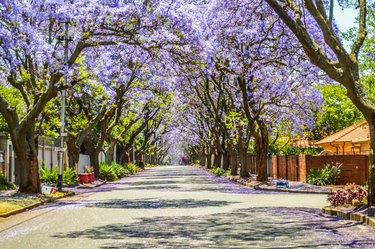
With a mass of lavender-blue blooms seeming to reach into the heavens, a flowering jacaranda tree (Jacaranda mimosifolia, USDA plant hardiness zones 9-11) is quite the sight to behold. These tropical trees are sure to be your landscape's rock star, making fabulously attractive specimens, especially when blooming. These are hardy trees and when it comes to diseases, jacaranda tree problems are few.
Jacaranda Tree Notable Characteristics
Video of the Day
Native to central and southern South America, jacaranda trees are fast-growing, eventually achieving a mature height of 25 to 40 feet with an open and spreading canopy of anywhere from 45 to 60 feet wide. Having a deciduous habit, jacaranda tree leaves are finely cut and fernlike and sprout again in spring. Trees usually produce a single trunk with grayish-brown bark that is smooth when immature, but it becomes blocky as the tree ages. Due to the jacaranda tree's fast growth, the wood is weak and prone to breaking, so don't plant it near a structure.
Video of the Day
With jacaranda trees, it's all about the striking flowers that start blooming in spring. Clusters of lavender-blue, trumpet-shaped blooms appear on 12- to 18-inch-long panicles and seem to fill the entire canopy with color. In fact, the blooms can appear before the light green foliage appears in spring. The flowers usually remain on the tree into summer. The spent blooms eventually form into 3-inch round capsules containing seeds. Between the jacaranda tree leaves dropping in winter and the dropped fruit capsules, the tree can be messy.
Minor Jacaranda Tree Problems
Jacaranda trees are plagued by few disease problems, so they won't turn into the fussy tree in your landscape. However, if you plant the tree in a location with poor drainage where the soil remains wet, the jacaranda can suffer problems with root rot and mushroom root rot, where mushroom formations appear around the tree's base. With rot problems, the entire tree loses vigor and will eventually die due to the soggy conditions.
If sap-sucking pests, like aphids, infest the jacaranda tree, you might notice a black substance forming on the jacaranda tree's leaves. However, an aphid infestation is usually not severe enough to treat and won't harm the tree. The black substance is a fungus called sooty mold, and unless it covers the majority of the tree, it only takes away from the tree's good looks and won't kill it.
The aphids excrete a sticky substance called honeydew that drips on the leaves and then promotes the sooty mold fungus. Many times, you might notice a stream of ants running up and down the trunk or branches, as they are milking the honeydew from the aphids. Depending on the jacaranda tree's size, you can wash the mold off the tree with a strong stream of water. Use soapy water to wash the foliage and leave it alone. If needed, you can also treat the aphids with an insecticide.
Oleander Leaf Scorch Disease
The most serious disease that affects jacaranda trees is oleander leaf scorch disease, for which there is no cur, and the tree eventually dies. The disease is mainly problematic in Southern California. Caused by the Xylella fastidiosa bacterium, the disease is mainly caused by sharpshooter insects that feed on the tree's xylem.
Signs of an infection are sometimes mistaken for drought, but if drought is the problem when the tree is once again watered, it recovers. With oleander leaf scorch disease, it doesn't. Jacaranda leaves begin yellowing and branches droop, and as the problem progresses, the foliage and branches eventually brown and die. Eventually, the disease overtakes the entire tree, and it dies, with hotter conditions making the disease more severe.
Although you can prune out damaged portions of the jacaranda to make the tree look better, removing the infected sections won't save the tree from dying. By the time the disease rears its ugly head, it's already spread throughout the jacaranda tree's xylem, so there's no saving it. The best thing you can do is remove the jacaranda tree from the landscape as soon as you identify the problem as oleander leaf scorch disease.